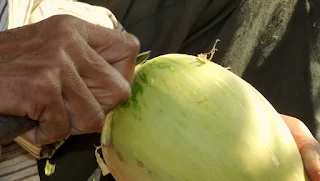 |
| Rushem: a traditional wind instrument |
 |
| Bitter-gourd ready to harvest for preparing shell of Rushem |
 |
| Scrapping the upper layer (skin) of the newly harvested gourd |
 |
| Keeping dry-gourd above the hearth for fumigation |
 |
| Process of seasoning bamboo pipes by placing on the hanging platform above the fire place to achieve constant fumigation |
 |
| Segmented and complete view of Rushem |
November and December is the right time to collect fine props of bamboo to be used as wind pipes of different sizes to be passed inside the body of a gourd from six different holes to produce different tunes in a defined note and scale. Interesting part of Rushem is the appropriate use of a bitter-gourd/ bottle gourd shell (Langenaria siceraria) as resonator.
The bitter gourd either wild or planted in the surrounding field or homestead land is given appropriate care and protection from any kind of unwanted damages or loss until it is collected. It is harvested when the lower part of the body turns brown in colour. The upper layer (skin) of the gourds selected for the preparation of Rushem are scrapped with sharp knife and it is exposed to sun for few days. Further for seasoning, it is kept above the hanging platform of fireplace (hearth) to get constantly fumigated. This traditional method of preservation is applied to prevent from unwanted attack of insects and termites. Similarly, small bamboo props/ reeds are also seasoned to utilise at the time of preparing Rushem.
Parts of Rushem
 |
| Fig: Parts of Rushem |
 |
| Bottle-gourd showing six holes and metal buzzers |
Rushem consists of a resonating body prepared from shell of bottle gourd. It is six reeds of bamboo with buzzers (Rushem Jang) made from thin plate of brass fixed uniformly in each of these wind pipe by inserting into the holes as arrayed in the figure illustrated above. The upper holes contain three large size Kache (bamboo reeds/ wind pipe) while other three are fitted in specified order just below the upper holes. While fitting these wind pipe bee-wax is used to conceal the holes tightly. Each of these Kache bears holes called Khor to play different tunes and notes. A bellow (Atumna), made of bamboo pipe is inserted from the mouth of the gourd. This bellow contains a notch near the bottom called Athi Supna for supplying wind uniformly into the shell to resonate from the vibrating sound of the buzzer. The buzzer being the most important part of Rushem, creates desirable sounds and notes. It is meaningfully represented by the name Rushem Jung which literary means the root/ genital of Rushem. According to a folk belief, 'Rushem Jung is the divine representation of father -the creator while womb-shaped body represents the divine mother. The divine union creates the most enchanting and beautiful sound of Rushem'.
 |
| Textile motif showing Rushem Jung (in colour) |
 |
| Rushem Jang (brass made buzzer) feather of Cock and paste obtained from the Conch shell by rubbing on stone used at the time of preparing buzzing wind pipe. |
Now a days, only a few elderly persons from Kom villages know this age-old craft of preparing Rushem. This traditional folk instrument having accumulated with native cultural elements, provide valuable information to peep into the socio-cultural and religious life of the Kom tribe.
* based on the field documentation held at Khoirentak Khuman, Kom Village, Manipur
Comments
I Belong to Thadou Tribe,largest single majority Tribe in manipur as per 2011 Census. The musical instrument you Highlight belongs to a Thadou-Kuki Tribe. The said instrument is spelled as "Goshem" but not "Rushem".
Goshem is a combination of two words in Thadou Dialect. "Go meaning Bamboo" and "Shem meaning Blow".
I therefore kindly request you to replace Rushem as Goshem.
Thanx in antipation!